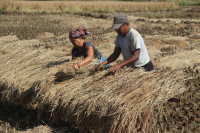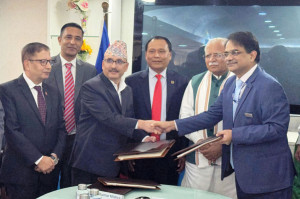Money
Bhairahawa ousts Birgunj as largest import gateway
Bhairahawa customs point has knocked Birgunj out of the top spot as the largest import gateway.
Bhairahawa customs point has knocked Birgunj out of the top spot as the largest import gateway. In the last fiscal year 2015-16, more imported goods poured into the country through Bhairahawa than Birgunj, suggesting that the fast-rising town located further west on the Nepal-India border will become a force to reckon with in the years to come.
Birgunj lost its shine following the protest movement launched by Madhesi parties and the Indian embargo which were largely concentrated here, leading traders to look for more convenient alternative routes to transport their goods.
As a result, more and more shipments were diverted through Bhairahawa, knocking Birgunj off the number one spot.
“During the blockade, many vehicle importers used Bhairahawa as an alternative import route,” said Sishir Dhungana, director general of the Department of Customs (DoC). “Even after normalcy returned in Birgunj, they have continued to operate from Bhairahawa.”
Most trading companies have rented land around Bhairahawa and constructed warehouses. Major auto importers like Sipradi Trading, Laxmi Hyundai and the Chaudhary Group have now been concentrated in Bhairahawa.
In the last fiscal year, the government collected the highest amount of customs revenue from vehicle imports. Besides automobile importers, iron importers have also chosen to route their shipments through Bhairahawa, said the DoC.
According to the DoC, 24.07 percent of Nepal’s imports in the last fiscal year took place through Bhairahawa followed by Birgunj with 23.5 percent and Biratnagar with 15.08 percent. Nepal imported goods worth Rs774.71 billion in the last fiscal year and shipments that arrived through Bhairahawa were valued at Rs186.48 billion.
The emergence of Bhairahawa as a major trade route is also reflected in the fact that revenue collection at Bhairahawa Customs was close to the amount collected at Birgunj Customs in the first month of the current fiscal year.
According to the DoC, the collection from Bhairahawa Customs amounted to around Rs5 billion while the collection from Birgunj Customs stood at around Rs7 billion. “Earlier, Bhairahawa Customs used to collect around one-third of the collection of Birgunj Customs. Now the ratio is 60:40 between Birgunj and Bhairahawa customs,” said Dhungana.
Birgunj-based businessmen also admit that Birgunj has been losing its charm. Vijay Kumar Sarawagi, a Birgunj-based businessman, said that due to recurring disturbances in Birgunj from the time the peace process began, traders have started losing patience and are scouting for more peaceful places for conducting business.
In the past, traders used to import all their goods through Birgunj and distribute them across the country. “Now they are importing goods through different customs points in a bid to cut delivery times and costs,” said Sarawagi, who is also the chairperson of the trade committee at the Federation of Nepalese Chambers of Commerce and Industry (FNCCI).
With regard to exports, Tribhuvan International Airport (TIA) in Kathmandu handled the largest volume of shipments followed by Biratnagar and Birgunj, in that order.




 16.12°C Kathmandu
16.12°C Kathmandu














